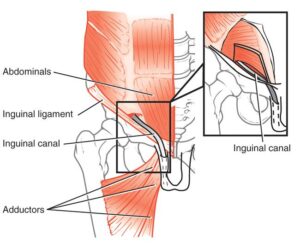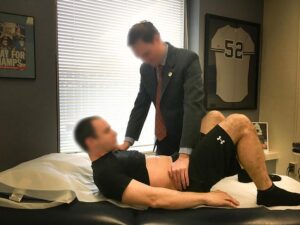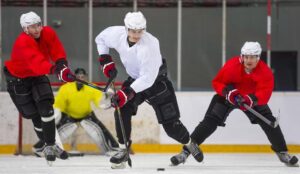A sports hernia, also known as athletic pubalgia, is a painful condition resulting from a soft tissue injury in the groin area. This injury frequently occurs during high-intensity sports that involve abrupt directional changes or forceful twisting motions.
While a sports hernia can sometimes progress to a conventional inguinal hernia, it is a distinct condition.
An inguinal hernia, the most common type of groin hernia, happens when abdominal tissue—such as a portion of the intestine—protrudes through a weak spot in the lower abdominal wall, often forming a noticeable, painful bulge. In contrast, a sports hernia involves a strain or tear in the soft tissues (muscles, tendons, or ligaments) located in the lower abdominal or groin region.
Since a traditional hernia is not always present in cases of sports hernia, the medical term “athletic pubalgia” is preferred. However, the term “sports hernia” remains widely recognized and will be used throughout this discussion for clarity.
Anatomy of a Sports Hernia
In cases of sports hernia, the most commonly affected soft tissues are the oblique muscles in the lower abdominal region. The tendons connecting these oblique muscles to the pubic bone are particularly susceptible to injury. Additionally, the adductor tendons, which attach the thigh muscles to the pubic bone, are often stretched or torn in conjunction with the oblique muscles, further complicating the condition.
 Sports hernias often occur where the abdominals and adductors attach at the pubic bone. Traditional hernias occur in the inguinal canal.
Sports hernias often occur where the abdominals and adductors attach at the pubic bone. Traditional hernias occur in the inguinal canal.
Causes of Sports Hernia
Sports hernias typically result from activities requiring high-intensity movements, such as planting the feet firmly while twisting the torso with maximum force. These motions can lead to tears in the soft tissues of the lower abdomen or groin.
This condition is most frequently observed in athletes participating in high-demand sports, including ice hockey, soccer, wrestling, and football, where sudden, forceful movements are common.
technotr/E+/Getty Images
Symptoms of a Sports Hernia
A sports hernia typically causes intense groin pain at the moment of injury. While the pain may subside with rest, it often returns upon resuming physical activities, especially those involving twisting motions.
Unlike a traditional inguinal hernia, a sports hernia does not produce a visible bulge in the groin area. However, over time, the condition may progress to an inguinal hernia, where abdominal organs push against weakened soft tissues, creating a noticeable bulge.
Without appropriate treatment, a sports hernia can lead to chronic, debilitating pain that prevents athletes from returning to their regular activities.
Doctor Examination
During your initial medical evaluation, your doctor will discuss your symptoms and the circumstances surrounding the injury. A physical examination is a key part of the diagnosis.
If a sports hernia is present, your doctor may detect tenderness in the groin or above the pubic bone. Although sports hernias can sometimes be associated with traditional inguinal hernias, most cases do not reveal any visible hernia during a physical examination.
Physical Tests
To confirm the diagnosis, your doctor may ask you to perform specific movements, such as a sit-up or trunk flexion against resistance. If you have a sports hernia, these actions are likely to cause pain, helping to identify the injury.
 A common sign of sports hernia is pain during a resisted sit-up.
A common sign of sports hernia is pain during a resisted sit-up.
Imaging Tests for Sports Hernia Diagnosis
Following a detailed physical examination, your doctor may recommend imaging tests, such as X-rays or magnetic resonance imaging (MRI), to confirm the presence of a sports hernia and rule out other conditions. In some cases, additional tests, such as bone scans, may be necessary to exclude other potential causes of groin pain.
Treatment Options for Sports Hernia
Nonsurgical Treatment
- Rest and Ice
During the first 7 to 10 days post-injury, resting and applying ice can alleviate pain and reduce swelling. If a bulge is present in the groin area, using compression garments or wraps may help relieve discomfort. - Physical Therapy
Approximately two weeks after the injury, physical therapy exercises can be introduced to improve strength and flexibility in the abdominal and inner thigh muscles. A structured therapy program is often key to recovery. - Anti-inflammatory Medications
Non-steroidal anti-inflammatory drugs (NSAIDs), such as ibuprofen or naproxen, may be prescribed to reduce inflammation and manage pain.With proper care, many athletes recover within 4 to 6 weeks and can return to sports activities. However, if pain persists or recurs upon resuming sports, surgical intervention may be necessary.
Surgical Treatment
- Surgical Procedures
Surgery to repair torn tissues in the groin can be performed using one of two methods:- Traditional open surgery, involving a single long incision.
- Endoscopic surgery, which utilizes small incisions and a camera (endoscope) to guide the procedure.
Both methods deliver comparable outcomes, with the choice depending on the specific case and surgeon’s recommendation.
- Inguinal Neurectomy
In some instances, cutting the inguinal nerve during surgery may be necessary to relieve chronic pain. This procedure, called an inguinal neurectomy, is often effective for pain management. - Rehabilitation Post-Surgery
After surgery, a tailored rehabilitation plan will focus on rebuilding strength and endurance. Most athletes can resume their sports activities within 6 to 12 weeks following surgery. - Surgical Outcomes and Additional Procedures
- Over 90% of patients treated with a combination of nonsurgical and surgical methods successfully return to sports.
- In rare cases, the repaired tissues may tear again, requiring a repeat surgery.
- For persistent inner thigh pain after surgery, an additional procedure known as adductor tenotomy may be recommended. This involves cutting the tendon attaching the inner thigh muscles to the pubis, allowing it to heal at a longer length, reducing tension, and improving range of motion.






